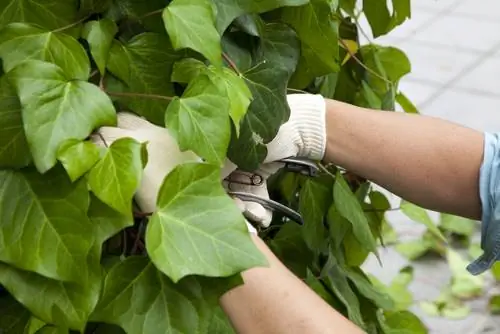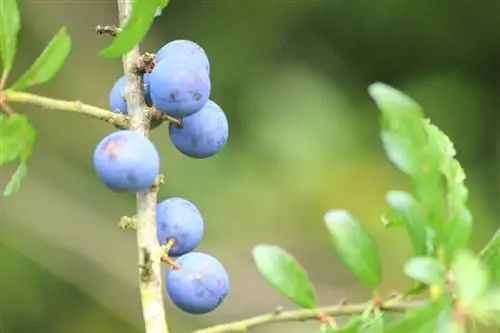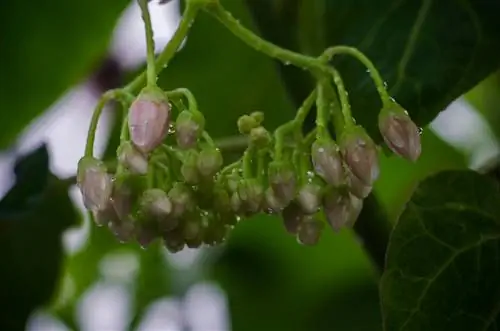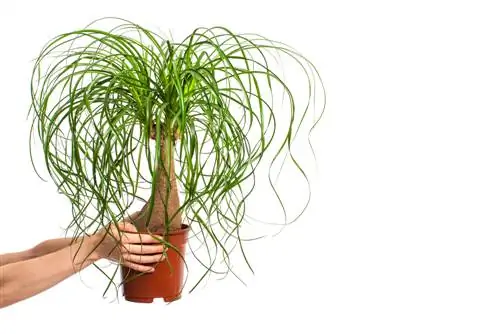- Author admin [email protected].
- Public 2023-12-16 16:46.
- Last modified 2025-06-01 06:02.
If an evergreen, easy-care climbing plant is on the planting plan, ivy is the first choice. In sunny to shady locations, the vigorous climbing shrub plants fences, trellises and facades or is useful as an opaque ground cover. A rapid growth rate of up to 100 centimeters per year makes pruning measures unavoidable. This tutorial explains when and how to prune ivy skillfully in a practical and beginner-friendly way.

Cutting ivy - cutting options and dates
Ivy makes gardening a fun endeavor. Apart from regular pruning, the climbing artist does not expect any significant care. Even newcomers to hobby gardening can't go wrong when cutting. There are no special pruning techniques that need to be followed to keep the vigorous green plant in its place. The following table summarizes all cutting options with tips for choosing the best date:
| Cut option | Goal/Occasion | best date |
|---|---|---|
| Topiary | shorten long tendrils, thin out dense trees | February |
| care cut | maintain a well-groomed appearance | End of June to mid-July |
| Rejuvenation cut | revitalize old climbing plant | January to early March |
| Elimination | Free the facade partially or completely from ivy | 1. October to February 28th |
Complete topiary in February
In the first few years after planting, ivy lulls its gardener into security because there is no noticeable rapid growth at first. Once the evergreen plant has established itself in the location, it provides convincing evidence of why it is one of the growth rockets. A targeted topiary shows the climbing plant its limits. It's so easy to direct growth in the desired direction:
- The best time is the end of January to the end of February in frost-free, cloudy weather
- Examine the climbing bush thoroughly for overwintering animals and cut later if necessary
- Cut back tendrils that are too long on climbing and ground-cover plants
- Thimout dead wood and unfavorably growing shoots
Go to work with good courage, becauseYou can't do anything wrong Be bold and clear your gutters, windows and doors if you feel bothered by ivy. On older plants, long, dead shoots with poisonous berries protrude horizontally from the green area. You can divert these to side shoots near the wall or near the ground with a radical cut.
Background
Cutting ivy falls under the Federal Nature Conservation Act
The good-natured pruning tolerance of ivy does not mean that you should use the scissors at any time of the year. As a woody climbing plant, ivy is subject to the strict requirements that the Federal Nature Conservation Act sets for tree pruning. Comprehensive cutting measures are prohibited from March 1st to September 30th. The reason for the grace period is the breeding season of our birds. In exceptional cases, light pruning may be carried out, provided that no more than this year's growth falls victim to scissors or saws. The exemption is no longer valid if wild animals in the plant devote themselves to their offspring. From October 1st to February 28th, all types of pruning are permitted, provided that it can be ruled out in advance that wild animals could be disturbed or driven away.
Grooming cut for a representative appearance
A summer grooming cut is the ideal complement to the winter topiary. Around St. John's Day (June 24th) is traditionally a good date for alight tree pruningAt this time, native plants take a short break in growth and then sprout again with reduced vigor. If you cut ivy between the end of June and mid-July, the climbing plant will maintain its well-groomed appearance for many weeks. It is important to note that the pruning is limited tothis year's growth. How to do it right:
- Choose a date for the summer cut on a covered, not too hot day
- Examine the climbing bush carefully for nesting birds
- Reschedule the date until the end of August if there are nests in the branches
- Cut back tendrils that stick out of shape or overhang
When pruning in summer, please remember that you will expose previously shaded leaves. It is therefore advisable not to prune ivy in direct sunlight. Alternatively, hang a shade net over the plant for a few days so that the lush green or variegated decorative leaves do not suffer from sunburn.
Excursus
Well equipped for the ivy cut
In the first few years, you can manage the pruning of an ivy hedge with a standard two-handed hedge trimmer (€41.00 at Amazon). If the climbing artist plants a small area, you can simply prune tendrils that are too long with one-handed pruning shears, either as bypass shears or anvil shears. Over time, the climbing plant conquers larger areas or facades and forms strong, woody shoots. A Japanese saw is helpful to create order here.
Revitalize old ivy plant
If ivy remains uncut for many years, conventional topiary pruning will not bring order to the dense network of tendrils. The good-natured pruning tolerance allows forradical rejuvenation pruning In this context, it is certainly possible to put the climbing plant on the stick. Cut all vines back to the thick rootstock. In the period that follows, the plant reliably sprouts again from its sleeping eyes. This approach is suitable for the option where renewed greenery with ivy is desired at the location. Complete elimination of roots and vines requires a draconian procedure, which you can read about in the following section.
Tip
When pruned, ivy can release small parts of the plant that you could inhale. Therefore, wear a respirator mask when undergoing a shape or rejuvenation cut.
Removing ivy from facades
The legendary growth and climbing power of ivy is both a blessing and a curse. If you let the evergreen climbing artist do what you want, you won't be able to get rid of her. The following removal methods are aimed at gardeners who are struggling with wall damage caused by ivy with its adherent roots. To weaken the climbing plant, carry out various preparatory work about a month in advance. The respective procedure takes into account the specific nature of the facade:
Preparatory work
- 3 to 4 weeks before removal: saw through all connections to the roots in the ground
- Remove as many vines as possible from the facade
Plastered masonry
- Attach the weed scraper to the telescopic handle and scrape off all plant residue
- Spray the remaining roots with a high-pressure cleaner
- Alternative: rent dry ice blasting system and work platform
- Spray dry ice directly onto the adhesive roots via a narrow pipe
- Remove the last bits of ivy with a wire brush
- Repair holes in the plaster or completely re-plaster the facade
Slate wall
- Scrape off remaining tendrils and roots with a scraper and triangular grinder
- Remove any remaining residue with 180 or 120 grit sandpaper
- Give slate surfaces a new shine with special cleaning agents
Ivy with strong tendrils does a great job on clinker facades. If you find yourself forced to clear the masonry of green growth, you are dealing with a hardened opponent. Patience and persistence are now required to completely eliminate the plant. Following the preparatory work, the ivy is already visibly weakened. With a high-pressure cleaner and dirt blaster, there is a good chance of removing the remaining root residue. You can get rid of the growth more effectively with a sandblaster. A compressor creates a strong stream of air that sprays sand from a container onto the wall at high speed. The adhesive roots have nothing to counteract this force and let go. A negative side effect is the risk that loose joint residues will come off under the pressure of the sandblaster.
Frequently asked questions
Is ivy poisonous?
All parts of ivy are poisonous to humans and animals. Skin contact with the plant sap can cause allergic reactions in sensitive people. The berries on older plants are full of toxic ingredients. If consumed, nausea, vomiting, stomach cramps and even shock with circulatory failure occur. Small children in particular are at risk. Ivy is not recommended for cultivation in the family garden. Cutting work requires wearing gloves and long-sleeved clothing if you do not want to risk severe itching.
We would like to cover a 1.80 meter high and 17 meter long south-facing fence with ivy to create a quick privacy screen. Which type of ivy is suitable for this purpose?
In this case, only small-leaved varieties can be considered and even these only with reservations. Like all evergreen plants, ivy continues to evaporate water from its foliage in winter. The sunnier and windier the location, the greater the likelihood of failure due to drought stress. It should also be borne in mind that young ivy plants thrive as light refugees. It takes at least 2 to 3 years before they decide to climb a fence in a sunny location.
I have heard that Hedera helix only flowers and bears fruit after many years and from that point on it no longer climbs. How long do I have to wait until the first flowering period?
It depends primarily on the local conditions when Hedera helix blooms and produces black berries for the first time. As a rule, you can expect a waiting period of between 8 and 10 years. For ivy plants, the beginning of an annual flowering period is only partially related to their ability to climb. If you take cuttings from the flowering shoots, you will get non-climbing ivy bushes. You can purchase these ready-made from specialist retailers under the variety name Hedera helxi Arborescens.
My ivy bloomed last summer. Now winter is over and the climbing plant is spoiled with brown leaves. Did the plant freeze? Can pruning solve the problem?
The flower has no connection with the brown leaves, but rather signals that your ivy has reached a certain age. After 10 to 15 years, ivy switches its propagation strategy to flowers with berries and seeds. The brown leaves are a result of drought stress in winter. If there is no snow cover to provide valuable moisture in severe frost and the winter sun is shining at the same time, a lot of water is lost through the warmed leaves. The roots cannot provide any supplies from the frozen ground, as a result of which the foliage dries up. After a while, the plant regenerates itself. If you feel bothered by the brown leaves, you can cut off the affected tendrils.
When does ivy stop growing?
Ivy is rightly the floral synonym for eternal life. The evergreen climbing plant never stops growing. The plant reproduces and rejuvenates itself tirelessly via its aerial and adhesive roots. Older plants supplement their dispersal strategy with flowers in September and October, which turn into berries with seeds.
I would like to green the 2 meter high concrete wall at my garage entrance from above. The wall is mostly in the shade and only receives a little sun in the afternoon, so I set my sights on Hedera helix. Does ivy also grow downwards?
Hedera helix prefers to grow upwards and is difficult to convince to let its tendrils hang down. More suitable for the project is the cotoneaster (Cotoneaster dammeri radicans), which is just as hardy and shade-tolerant as ivy, but has no objection to hanging growth.
Does ivy in the balcony box need winter protection?
Hedera helix planted outdoors is usually well hardy and does not require any protection. In the balcony box, however, the roots are vulnerable to severe frost. If the thermometer consistently falls below -10 degrees Celsius, we recommend a warm protective coat. Cover the box with foil, fleece or simply old sacks. If the winter sun shines directly on the evergreen tendrils in frosty temperatures, a shade net is helpful. Heavily heated ivy leaves evaporate a lot of water, while the roots in the frozen substrate cannot absorb moisture and the plant dries up.
The 3 most common cutting mistakes
Even experienced home gardeners rub their eyes in amazement when ivy suffers from sunburn or frost damage after being cut. The climbing plant is not completely indestructible, because the following 3 cutting errors cause unexpected damage that can easily be avoided.
| Cutting errors | malicious image | Prevention |
|---|---|---|
| cut in frost | frozen back vines with dead leaves | never cut at temperatures below -3 degrees Celsius |
| cut in full sun | exposed leaves with sunburn | always cut when the weather is overcast |
| never cut and planted without a trellis | Damage to facade and walls | Plant with climbing aid at least 5 cm from the wall and prune regularly |
Violent coughing and itchy skin are also common problems after improper ivy pruning. Without respiratory protection, tiny parts of plants can get into the lungs and trigger the annoying cough. If the plant sap comes into direct contact with your skin, excruciating itching is inevitable. Please only use the scissors if you have put on a respiratory mask, gloves and long-sleeved clothing.

Tip
Ivy prefers to grow under dark wooden cladding. Even the eaves of the roof are not safe from the green tendrils. Install a sheet of metal that is at least 15 centimeters wide and faces outwards and downwards at an angle below vulnerable eaves. This barrier cannot be overcome for ivy shoots. Attach the sheet metal so that it fits snugly against the wall of the house and is at least 30 centimeters away from the roof.






